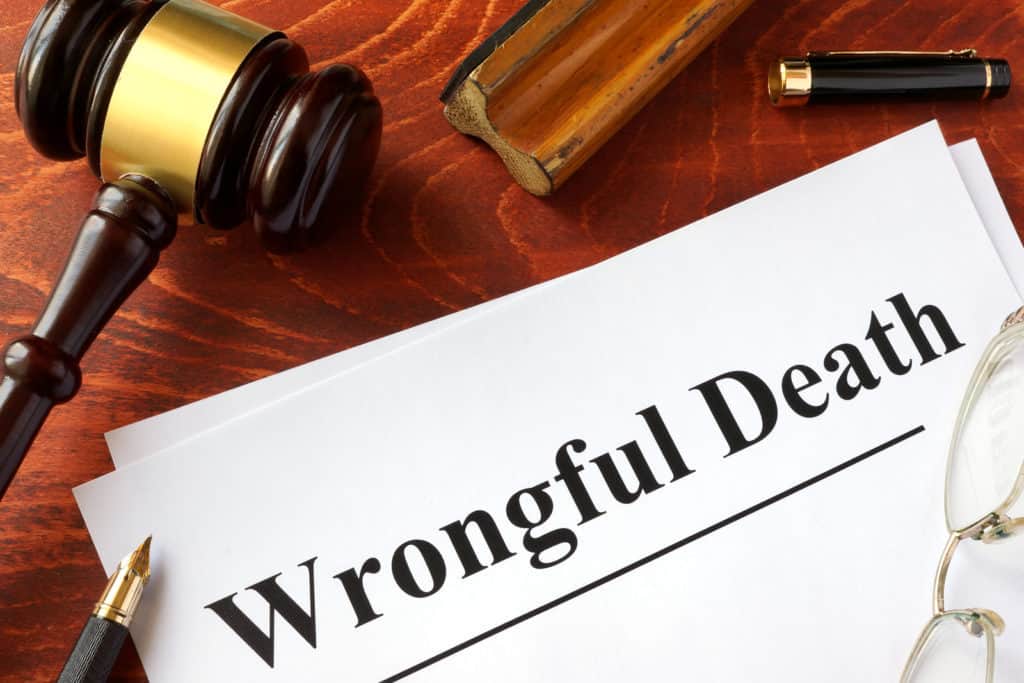Losing a loved one is always devastating. When that death results from someone else’s negligent or intentional actions, the pain can be compounded by questions about justice and financial security.
If you’re facing this unimaginable situation, understanding wrongful death lawsuits may help you protect your family’s future while holding responsible parties accountable.
What is a Wrongful Death Lawsuit?
A wrongful death lawsuit is a civil legal action that allows certain family members to seek compensation when their loved one dies due to another person’s or entity’s wrongful conduct.
In California, a wrongful death occurs when one person dies because of the misconduct of another person or entity. This misconduct can range from negligence (like a car accident caused by texting while driving) to intentional acts (such as assault or murder).
It’s important to understand that wrongful death lawsuits are civil matters, not criminal cases. The same act or event can give rise to both a wrongful death lawsuit and a criminal homicide prosecution.
For example, if someone causes a fatal drunk driving accident, they may face criminal charges while the victim’s family simultaneously pursues a civil wrongful death claim. Since the standard of proof in a wrongful death claim is less stringent than it is for criminal cases, it’s not uncommon for a defendant to be acquitted of murder or manslaughter and still be found liable for wrongful death.
The Four Essential Elements of a Wrongful Death Case
To successfully bring a wrongful death lawsuit in California, you must prove four essential legal elements. Unlike the original article suggested, the burden lies with the plaintiff (the person filing the lawsuit), not the defendant (the person being sued).
1. Duty of Care
The first element requires proving that the defendant owed your loved one a duty of care. This means they had a legal responsibility to act reasonably to prevent harm. The defendant had a responsibility to act safely. For example:
- Drivers have a duty to operate their vehicles safely and follow traffic laws
- Doctors have a duty to provide medical care that meets professional standards
- Property owners have a duty to maintain reasonably safe conditions for visitors
- Employers have a duty to provide a safe workplace for employees
- Manufacturers have a duty to produce products that are reasonably safe when used as intended
2. Breach of Duty
The second element requires showing that the defendant breached (violated) their duty of care. Failed in that duty. This means they acted unreasonably under the circumstances or failed to act when they should have. Examples include:
- A driver running a red light or driving under the influence
- A surgeon operating while impaired or making a preventable error
- A landlord failing to repair a dangerous staircase after being notified
- An employer ignoring known safety hazards
- A company selling a product with a dangerous defect they knew about
3. Causation
Causation is often the most complex element to prove. You must show that the defendant directly caused your loved one’s death. You must demonstrate two types of causation:
Factual Causation: The breach of duty was a factual cause of the death (the “but for” test – but for the defendant’s actions, would your loved one still be alive?)
Legal Causation: The death was a foreseeable result of the defendant’s breach of duty
For instance, if someone with a known heart condition falls down poorly maintained stairs and dies, the defense might argue the death was caused by the heart attack, not the fall. Your legal team would need to prove that the fall either caused the heart attack or significantly contributed to the death.
4. Damages
If you can establish the death of your loved one was caused by the negligent or wrongful act of another person, the next step is to show you have sustained damages as a result of your loss. The final element requires proving that the death caused measurable harm to the surviving family members. This includes both economic and non-economic losses, which we’ll explore in detail below.
Who Can File a Wrongful Death Lawsuit in California?
Under California state law, the only party who can file a wrongful death claim is the deceased’s closest surviving beneficiaries. California’s wrongful death statute establishes a specific order of priority for who can file these lawsuits:
First Priority
The surviving spouse, domestic partner, children, and issue of deceased children have the first right to file. This includes:
- The deceased’s surviving spouse or registered domestic partner
- Biological, adopted, and stepchildren
- Grandchildren (if their parent who was the deceased’s child has also died)
If No First-Priority Survivors Exist
If there is no surviving issue (such as children and grandchildren), any family who would be entitled to the decedent’s property as if there were no will. This typically includes parents, siblings, and other close relatives who would inherit under California’s intestate succession laws.
Special Categories
The following people if they were dependent on the decedent: A putative spouse (which is a spouse who in good faith believed the marriage was valid, but it was not), children of the putative spouse, stepchildren, or parents. Minors who lived with the decedent the prior 180 days and were dependent on them for at least 50% of their support.
Important Note: The “One Action” Rule
The “one-action rule” in wrongful death cases in California prevents one defendant from being sued multiple times by various family members of the deceased. In the place of multiple lawsuits, the family may come together to file a single wrongful death suit. This means all eligible family members must participate in one lawsuit rather than filing separate cases.
Types of Damages Available
California wrongful death law allows recovery for both economic and non-economic damages. The damages are intended to compensate the family for losses they suffer due to the death, not to punish the defendant (though punitive damages may be available through a separate “survival action”).
Economic Damages
Economic damages are financial losses that can be calculated with relative precision:
- Lost Income and Benefits: The money your loved one would have earned during their expected lifetime, including salary, bonuses, retirement benefits, and other employment-related compensation
- Lost Support: Financial support the deceased provided to family members
- Funeral and Burial Expenses: Reasonable costs for funeral services, burial or cremation, and related expenses
- Medical Expenses: Medical bills incurred before death related to the fatal injury
- Loss of Household Services: The value of services your loved one provided, such as childcare, housekeeping, home maintenance, and yard work
- Lost Gifts and Benefits: Money or items your loved one would have given to family members, such as expected inheritances or regular financial gifts
Non-Economic Damages
The loss of the decedent’s love, companionship, comfort, care, assistance, protection, affection, society, moral support. These damages compensate for emotional and relational losses:
- Loss of Companionship: The comfort, care, and society your loved one provided
- Loss of Love and Affection: The emotional support and love that can never be replaced
- Loss of Guidance and Counsel: Particularly relevant for the loss of parents or mentors
- Loss of Protection: The sense of security your loved one provided
Recent Changes: Decedent’s Pain and Suffering
On October 1, 2021, California Governor Gavin Newsom signed into law SB 447, which amended California Code of Civil Procedure section 377.34 to permit wrongful death claimants in California to recover damages for decedents’ pain, suffering or disfigurement. As of 2022, wrongful death plaintiffs can also seek damages for the decedent’s pain, suffering, or disfigurement. This significant change applies to cases filed between January 1, 2022, and January 1, 2026.
What Damages Are NOT Available
It’s important to understand what you cannot recover in a wrongful death lawsuit:
- California courts have consistently held that damages for emotional distress are not recoverable in a wrongful death action
- Your own grief, sorrow, or mental anguish
- An heir cannot generally recover punitive damages in wrongful death cases under California law. The exception is if the deceased was killed as the result of felony homicide for which the defendant has been convicted
Common Causes of Wrongful Death
Wrongful death cases can arise from virtually any situation where someone’s negligent or intentional actions result in death. Many of the wrongful death cases we see in California stem from: Car accidents (including hit-and-run or being hit by a DUI driver). Common scenarios include:
Motor Vehicle Accidents
- Car, truck, and motorcycle accidents
- Pedestrian and bicycle accidents
- Accidents involving drunk, distracted, or reckless drivers
- Public transportation accidents
Medical Malpractice
- Surgical errors and complications
- Misdiagnosis or delayed diagnosis
- Medication errors
- Birth injuries resulting in infant death
- Failure to monitor patients properly
Workplace Accidents
- Construction site accidents
- Industrial accidents and explosions
- Exposure to toxic substances
- Falls from heights
- Equipment malfunctions
Premises Liability
- Slip and fall accidents
- Swimming pool drownings
- Defective staircases or railings
- Inadequate security leading to assault
- Building collapses or structural failures
Product Liability
- Defective automotive parts
- Dangerous pharmaceuticals
- Faulty medical devices
- Unsafe consumer products
- Industrial equipment failures
Criminal Acts
Criminal violence is a form of intentional misconduct that can justify a claim for financial compensation. This includes assault, murder, and other violent crimes where the perpetrator or a third party (like a property owner who failed to provide adequate security) may be held liable.
The Legal Process and Burden of Proof
Standard of Proof
In most civil lawsuits, including wrongful death cases, the defendant’s liability need only be shown by a “preponderance of the evidence.” Under this legal standard, the plaintiff must show it’s more likely than not that the defendant is responsible for the decedent’s death. This means the plaintiff must offer evidence that shows their claims have more than a 50% chance of being true.
This is a much lower standard than criminal cases, which require proof “beyond a reasonable doubt.” Civil court cases don’t require as high a standard for proof, making claims easier to prove.
Investigation and Evidence Gathering
Building a strong wrongful death case requires thorough investigation and evidence collection. This often includes:
- Accident reconstruction
- Medical record review
- Expert witness testimony
- Financial analysis of future losses
- Witness interviews
- Document collection and review
The Litigation Process
Most wrongful death cases follow this general timeline:
- Initial Consultation: Meet with an experienced wrongful death attorney to evaluate your case
- Investigation: Your legal team conducts a thorough investigation to gather evidence
- Filing the Lawsuit: The wrongful death complaint is filed in court
- Discovery: Both sides exchange information and evidence
- Expert Analysis: Experts calculate damages and provide opinions on liability
- Settlement Negotiations: Many cases settle before trial and some before filing a lawsuit
- Trial: If no settlement is reached, the case goes to trial
- Resolution: Either through settlement or court verdict
Time Limits: The Wrongful Death Statute of Limitations
Time is critical in wrongful death cases. Under California state law, the wrongful death statute of limitations for a wrongful death case is two years. The time limit by which to file a wrongful death claim begins on the day that the victim in question died.
Important Exceptions and Variations
Medical Malpractice Cases: If the death was caused by medical malpractice, however, the statute of limitations is the earlier of: [three years from the date of injury or one year from discovery]
Government Entities: When filing a lawsuit against a government entity in California, the statute of limitations is six months from the date of death
Discovery Rule: In California, the discovery rule states that the statute of limitations only starts once the family becomes aware that negligence caused the death of their loved one
Why Timing Matters
Missing the statute of limitations deadline typically means losing your right to seek compensation forever. If the case isn’t filed in court within two years, the family almost certainly loses the right to sue. Additionally, evidence becomes harder to collect over time, witnesses’ memories fade, and important documents may be lost or destroyed.
Wrongful Death vs. Survival Actions
California law recognizes two distinct types of claims when someone dies due to another’s wrongful conduct:
Wrongful Death Action
A wrongful death claim is a lawsuit to recover your direct losses as a grieving family member. This compensates survivors for their losses resulting from the death.
Survival Action
A survival action is a lawsuit to recover your loved one’s losses prior to death. This lets the heirs sue on behalf of the deceased’s estate for claims the decedent had the right to sue for as of the date of death, and/or claims for the injury that caused the death, provided the decedent survived those injuries for at least some period of time.
In many cases, eligible family members will be able to recover compensation through both types of claims.
Why You Need an Experienced Attorney
A wrongful death claim isn’t one you want to try to settle without expert legal help. These cases involve complex legal issues, extensive investigation, and sophisticated damage calculations that require specialized expertise.
What an Attorney Provides
Legal Expertise: Understanding California’s wrongful death laws and how they apply to your specific situation
Investigation Resources: Access to accident reconstruction experts, medical professionals, and other specialists
Damage Calculation: Establishing these damages is often difficult and requires significant expert analysis. For example, in determining how much a person would have made for his or her career, it is necessary to take many factors into account, including life expectancy, the normal course of advancement for a person in his or her position, inflation, and education, skills, and abilities. This complexity is why a wrongful death settlement calculator cannot provide accurate estimates—each case requires individual professional analysis.
Negotiation Skills: Experience in dealing with insurance companies and defense attorneys
Trial Experience: The ability to present your case effectively in court if settlement negotiations fail
No Upfront Costs
Most wrongful death attorneys work on a contingency fee basis, meaning you pay no attorney fees unless they recover compensation for your family. This arrangement allows families to pursue justice without worrying about upfront legal costs during an already difficult time.
Moving Forward After Loss
While no amount of money can bring back your loved one or fully compensate for your loss, a wrongful death lawsuit can provide several important benefits:
- Financial Security: Compensation for lost income and future support can help ensure your family’s financial stability
- Accountability: Holding responsible parties accountable may prevent similar tragedies from happening to other families
- Closure: The legal process can provide a sense of justice and closure for grieving families
- Peace of Mind: Knowing that your loved one’s death was not in vain and that steps may be taken to prevent future harm
Frequently Asked Questions About Wrongful Death Lawsuits
Are wrongful death settlements taxable in California?
In most cases, wrongful death settlements in California are not taxable. According to the Internal Revenue Service (IRS) under IRS Rule 1.104-1, the settlement amount received from a wrongful death settlement is not taxable because the IRS classifies it as part of a claim stemming from personal injuries or physical illness.
What IS NOT Taxable:
- Compensatory damages (economic and non-economic)
- Medical expenses and funeral costs
- Lost income compensation directly related to the death
What MIGHT BE Taxable:
- Punitive damages (rarely awarded in California wrongful death cases)
- Interest earned on settlement funds
- Medical bills previously deducted from taxes in prior years
It’s important to consult with both your attorney and a tax professional to understand the specific implications for your settlement.
What are the chances of winning a wrongful death suit in California?
The chances of winning a wrongful death suit in California are generally favorable for families with strong cases and experienced legal representation. Unlike criminal cases requiring proof “beyond a reasonable doubt,” wrongful death cases only need “preponderance of evidence” (more than 50% likelihood).
Factors That Improve Your Chances:
- Clear evidence of negligence or wrongful conduct
- Experienced wrongful death attorney with proven track record
- Prompt filing within the statute of limitations
High Success Rate Cases: Motor vehicle accidents with clear fault, obvious medical malpractice, workplace accidents with safety violations, and product liability with documented defects.
More Challenging Cases: Cases where the deceased shared fault, limited evidence situations, or cases involving government entities with shorter deadlines.
Experienced wrongful death attorneys report success rates of 85-95% for cases they take to trial, though most cases (approximately 95%) settle before trial.
Can I use a wrongful death settlement calculator?
While wrongful death settlement calculators exist online, these tools are not reliable and should not be used for making legal decisions. Wrongful death cases are too complex and individualized for automated calculators to provide accurate estimates.
Why Settlement Calculators Don’t Work:
- Every case involves unique facts, relationships, and damages
- Future earnings and life expectancy require expert analysis
- Legal variables like liability and insurance coverage vary significantly
Better Alternatives:
- Free attorney consultations for case evaluations
- Expert economic analysis by professionals
- Review of comparable cases in your jurisdiction
What Determines Real Settlement Values: The deceased’s age and life expectancy, current and projected earnings, relationship to survivors, circumstances of death, available insurance coverage, and quality of legal representation.
Consult with an experienced California wrongful death attorney for a realistic assessment based on your specific case facts.
What is the wrongful death statute of limitations in California?
The wrongful death statute of limitations in California is generally two years from the date of death. You must file your lawsuit within this timeframe or lose your right to seek compensation.
Key Timing Rules:
- Standard Cases: 2 years from date of death (most accidents and negligence cases)
- Medical Malpractice: Earlier of 3 years from injury or 1 year from discovery
- Government Entities: 6 months from date of death (much shorter deadline)
Discovery Rule Exceptions: In some cases, the statute may begin when the family discovers that negligence caused the death, particularly when the cause wasn’t immediately apparent or when fraud/concealment occurred.
Why Deadlines Matter: Missing the wrongful death statute of limitations typically means losing your case permanently. Evidence also becomes harder to collect over time, and witness memories fade.
If you’re approaching any deadline, contact an attorney immediately to preserve your rights.
What is the average payout in a wrongful death suit in California?
Recent data shows an average wrongful death settlement in California of approximately $973,054, with a median of around $294,728, though these numbers can be misleading because every case is unique, and can depend on the defendant’s ability to pay and available insurance proceeds.
Settlement Ranges:
- Typical range: $250,000 to $500,000 for many cases
- Lower-end settlements: $100,000 to $300,000
- Higher-end cases: $500,000 to several million dollars
Important Note: There is no true “average” wrongful death settlement number. While wrongful death settlement amounts can fluctuate anywhere from several hundred thousand dollars to upwards of a million dollars, it all depends on the specific circumstances of each case.
Factors affecting settlement amounts include the deceased’s age, income, dependents, circumstances of death, degree of negligence involved, and the availability of insurance and other assets.
How do I file a wrongful death lawsuit in California?
Filing a wrongful death lawsuit involves several critical steps:
- Determine Eligibility: Verify that you have legal standing to file (spouse, children, parents, or other qualifying family members)
- Act Quickly: Remember California’s 2-year statute of limitations from the date of death
- Consult an Attorney: Wrongful death cases are complex and require specialized legal expertise
- Investigation: Your attorney will gather evidence, interview witnesses, and consult experts
- File the Complaint: Your lawyer will file the formal legal documents in the appropriate court
- Discovery Process: Both sides exchange information and evidence
- Settlement Negotiations: Most cases settle before trial
- Trial: If no settlement is reached, the case proceeds to trial
Special Timing Notes:
- Standard cases: 2 years from date of death
- Medical malpractice: Earlier of 3 years from injury or 1 year from discovery
- Government entities: 6 months from date of death
How do I find a wrongful death attorney in California?
Finding the right attorney is crucial for your case’s success:
Look for:
- Specific experience in wrongful death cases
- Track record of successful settlements and verdicts
- Knowledge of California wrongful death law
Questions to Ask:
- How many wrongful death cases have you handled?
- What is your success rate?
- What is your fee structure?
Fee Structure: Most wrongful death attorneys work on contingency, meaning you pay no attorney fees unless they recover compensation for your family.
Who can file a wrongful death lawsuit in California?
California law establishes a specific hierarchy of who can file:
First Priority:
- Surviving spouse or registered domestic partner
- Children (biological, adopted, or stepchildren)
- Grandchildren (if their parent who was the deceased’s child has also died)
If No First-Priority Survivors: Anyone entitled to the deceased’s property under intestate succession laws (typically parents, siblings, other relatives)
Special Categories: Putative spouse, stepchildren or parents who were financially dependent, and minors who lived with the deceased for 180+ days and depended on them for 50%+ of support.
Important: California’s “one action rule” requires all eligible family members to participate in a single lawsuit rather than filing separate cases.
Who gets the money in a wrongful death lawsuit?
Typically, a wrongful death settlement is divided equally in California. The funds are distributed among all the beneficiaries who pursued the claim. It is not unheard of to give a larger amount to the victim’s surviving spouse or children while the rest of the claimants divide what is left among themselves.
Distribution Factors:
- Relationship to the deceased
- Financial dependency on the deceased
- Age and needs of survivors
Common Arrangements:
- Equal distribution among all beneficiaries
- Larger portion to surviving spouse and minor children
- Court-supervised distribution for minor children
The specific distribution is ultimately decided by the family or, if they cannot agree, by the court.
How do you prove wrongful death in California?
To prove wrongful death, you must establish four essential elements:
1. Duty of Care: The defendant owed your loved one a legal duty to act safely (drivers must follow traffic laws, doctors must meet medical standards)
2. Breach of Duty: The defendant violated their duty through action or inaction (running red light, surgical error, unsafe premises)
3. Causation: The breach directly caused your loved one’s death – both factual causation (“but for” the defendant’s actions) and legal causation (foreseeable result)
4. Damages: The death caused measurable harm to surviving family members, including economic losses (lost income) and non-economic losses (companionship)
Burden of Proof: You must prove these elements by “preponderance of evidence” (greater than 50% chance) that the defendant caused the death.
Common Evidence: Accident reports, medical records, expert testimony, financial records, witness testimony, and expert damage analysis.
Conclusion
Losing a loved one due to someone else’s negligence or intentional actions is devastating. While no legal action can undo your loss, California’s wrongful death laws provide a pathway to financial recovery and accountability.
Understanding your rights and acting quickly is essential. With California’s strict two-year statute of limitations and the complexity of these cases, early legal guidance can protect your family’s rights and maximize your chances of success.
Remember, each wrongful death case is unique. An experienced California wrongful death attorney can evaluate your case, explain your rights, and guide you through the legal process with the compassion and expertise your family deserves during this challenging time.



